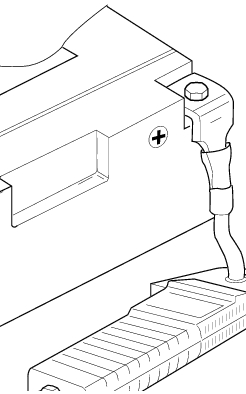
Ducati Diavel Service Manual: Checking the battery charging system
To check the current flow of the recharging circuit, use the "dds" diagnosis instrument, which is equipped with an inductive clamp-type amperemeter: refer to chapter "testing the battery charging system", sect. 6 - 11 With the dds diagnosis instrument you can determine the engine rpm required for the alternator to produce sufficient current to charge the battery, feed the injection/ignition system and all the electrical equipment on the motorcycle. When applied to a cable, the clamp-type amperemeter detects the magnetic field generated by the current passing through that cable.
The tester performs an automatic calibration routine using its own transducer. If the measured current is a positive quantity, it means that generator is feeding all electric items and charging battery at the same time. A negative value means that charging system is not powering the loads and a significant amount of current must be supplied by the battery, which is discharging at the time of the measurement.
Or it is possible to use a multimeter (sect. 6 -11, Diagnostic instruments); connect the multimeter probes to the battery terminals, select the dc scale on the instrument and check for the presence of 14.5 V+/-0.5 At an engine speed of 3000 rpm.
Important
If polarity is reversed when clamping the ammeter onto the cable, the sign of the readings will also be reversed, giving rise to incorrect diagnosis.

 Recharging the battery
Recharging the battery
Examine the label on the battery showing the check intervals in order to
determine when to test the voltage.
Charge the battery if the open circuit voltage is lower than 12.8 V. Leaving
the b ...
Other materials:
Active key
Introduction
The active key (1) communicates with the hands free system by radio. In order
to function, the key must be within a 1.5
Metre radius from the antenna (located in the document compartment under the
seat).
In the event of a flat key battery or of an internal transmitter circuit f ...
Reassembly of the oil pump
Check that the circlip (3) and tongue (13) are present on the pump.
Fit the pump drive gear (12) on to the oil pump and secure it by installing the
circlip (6) in its groove.
Insert the by-pass valve pump (17), the spring (16) and screw the plug (14).
Tighten the plug (14) to a torque of ...
Entering pin code function for vehicle release
This function turns on the motorcycle "temporarily" in the
case of hf (hands free) system "malfunctions".
To activate the function, press the "emergency" hands free
button (7, fig. 87) If the motorcycle cannot be turned on using
the normal starter button.
After ...
